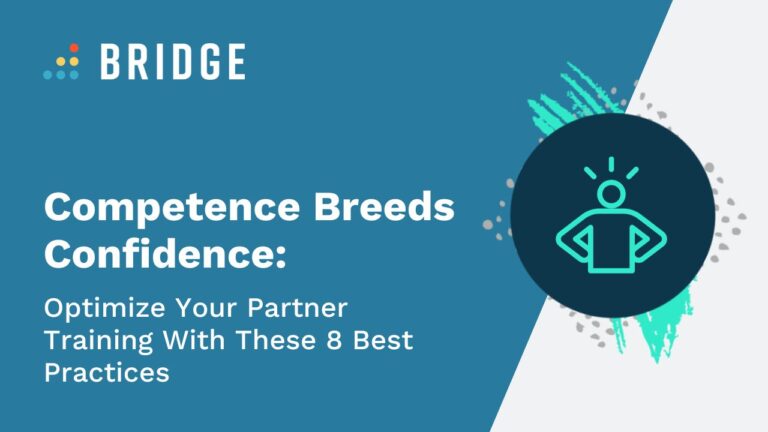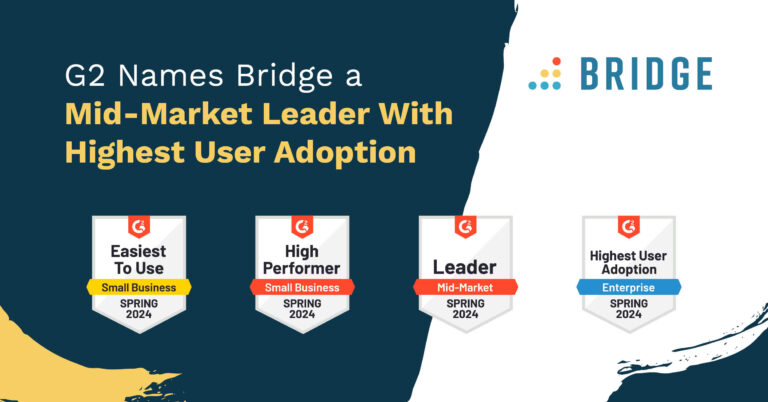Learning and development (L&D) is a powerful tool when it comes to sales. According to research from McKinsey, outperforming organizations place a huge emphasis on getting sales training right. They commit to 79% more coaching than slow-growing organizations, they’re 57% more likely to tailor learning programs for their sales teams, and they’re 1.3 times more likely to surpass their peers in terms of revenue growth.
Here’s the thing: none of these findings are a surprise. You don’t need a squad of McKinsey analysts to tell you that well-trained salespeople lead to better business outcomes. And if this training-first approach to managing your internal sales team feels natural and intuitive, it might be time to ask yourself: “does my organization hold the same attitude toward our partners?”
For many organizations, the answer to that question is: “not exactly.” In fact, according to Deloitte, “most workforce-related practices, systems, and processes focus on employees, not external contributors.”
When you work with partner organizations who help to deliver your product and contribute to your revenue, this approach doesn’t add up. Your external partners will benefit from the same sales enablement resources that generate success among your employees—and by giving partners access to those resources, you’ll put yourself on the path to exactly the kind of outperformance that feels so natural when it’s the product of internal training.
So, how do you make sure your partners are getting trained to a good standard? How do you offer them the right levels of personalization, incentivization, and access? Let’s find out.
The Top Challenges Involved in Training Your Partners
Training external workers comes with a different set of challenges to training your in-house workforce. We’ve found that when it comes to partner training, a few pain points tend to crop up. These include:
- Content discovery
- Providing access and permissions to relevant content
- Encouraging external workers to embrace training
- Providing partner-specific content
- Understanding what aspects of your training are working
All of these challenges can be addressed with the right tools, tech, and best practices—and the advantages of doing so are pretty compelling.
The Benefits of (Good) Partner Training
In many ways, the benefits of partner training overlap with the benefits associated with training internal employees. It goes without saying that a well-trained workforce will be more competent and confident in its work, and there’s doubtless a similar story to be told among external partners, too. But let’s hone in a little.
According to McKinsey, one large telco organization saw a 10% increase in deal size per rep when it rolled out channel-specific learning journeys, a certification program for external agents, and gamified elements.
The benefits here speak for themselves: there are fantastic sales and revenue implications for taking partner training seriously. But it’s also worth taking a moment to think about how that training was taken seriously. The telco clearly approached its external training with partners in mind. It placed an extra emphasis on incentivization through its certifications and rewards, and it also took a data-informed approach by building training around skills that, according to its own analyses, led to increased productivity.
8 Best Practices for Setting up a Successful Partner Training Program
McKinsey’s example of external training in action draws on several of the best practices that make for first-class partner training. Some of these practices are much the same as those you’ll encounter in good internal training, like personalization and using data to your advantage, whereas others have more application in a partner training context. Incentives, for example, like certification and gamified components, are more important among learner populations who view your training as optional—as opposed to your own employees, who may have less of a choice about whether or not to complete it!
These aren’t the only best practices that partner training needs to account for—but we’ve got you covered in this hand-picked selection of practical approaches.
1) Prioritize Partner Onboarding
Across these best practices, you’ll spot a theme that we’ve already touched on: partner training (and other forms of external training) isn’t usually mandatory. You can’t necessarily enforce it in the same way that you can with your employee development programs.
That means you need to really pull out all the stops if you want to encourage your partners to engage with your learning resources—and there’s no better place to start than with learner onboarding.
By providing your partners with an effortless and engaging experience from the word “go”, you’ll establish the perfect precedent for long-term collaboration. The right learning management system (LMS) will support this process through onboarding journeys or pathways, allowing you to space out the onboarding process at timed intervals (more on that later!).
RELATED READING | ‘5 Ways to Achieve Better Employee Onboarding With Bridge Journeys’
2) Make It Easy to Search for Moment-of-Need Content
When external partners come to your learning tool, they’re usually there for a specific (and sometimes urgent!) reason. They want information quickly: maybe something’s gone wrong, or they’ve forgotten a crucial piece of knowledge, or they want a reminder of how to apply their training in a specific way. In other words: they’re often learning in the moment of need.
With strong search features combined with easily accessed video training content, you’ll allow external learners to instantly address their queries. When partners need to refresh their memories on key moment-of-need information like how to use your point of sale system or which talk tracks to use when they’re out selling, it all starts with good search capabilities.
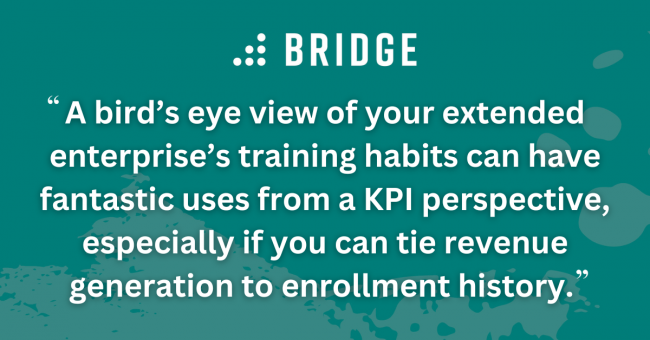
3) Use Analytics to Track Usage and Learner Success
LMS-based reporting and analytics are fantastic tools—for you and for your partners.
From a partner’s point of view, a little data can go a long way when it comes to keeping an eye on user activity, allowing them to track which of their users are taking full advantage of your learning resources.
From your point of view, you’ll be able to figure out which partners are taking the most training. This bird’s eye view of your extended enterprise’s training habits can have fantastic uses from a KPI perspective, especially if you can tie revenue generation to enrollment history.
When you’ve got the data to prove that your training works—or if you can figure out where your training needs improvement—you and your partners can only benefit.
DISCOVER THE VALUE OF DATA | ‘The Power of Learning Analytics to Drive Decisions and Growth’
4) Take Advantage of Different Access and Permissions Levels
When it comes to levels of access for your content, there’s no set-in-stone best practice. The permissions you grant your partners will inevitably change the dynamic of how they interact with your content, and your job is to discern which level of access is appropriate for different kinds of content and different partners.
For example, let’s return to the idea of moment-of-need videos. If you think your partners will benefit from quick reminders of key information, delivered via a YouTube-style portal, then you’ll want to ensure there are few (or no, if possible) barriers to accessing that content.
If, on the other hand, you’re looking for data to feed your analytics, you’re going to want a higher barrier to access. This might look like a gated access form or a registration and account creation process. It’s a slightly less convenient process for your learners, but it’ll put you in a prime position to take full advantage of those handy data points we discussed above.
You’ll also want to factor content sensitivity into the equation: the more sensitive the content you’re distributing to your partners, the tighter your access protocols should be.
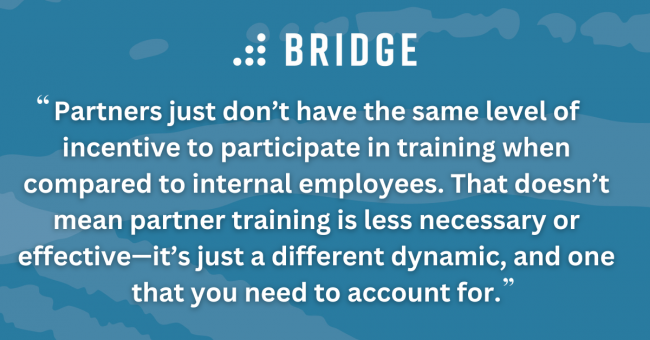
5) Incentivize Training With Certifications
You may see the benefits of implementing higher barriers to access key content, but the added steps of logging into your learning platform can exacerbate the biggest challenge in the world of partner training: incentive.
Partners just don’t have the same level of incentive to participate in training when compared to internal employees. That doesn’t mean partner training is less necessary or effective—it’s just a different dynamic, and one that you need to account for.
One of the best ways to do this is by generating your own incentives. With the appropriate access and permissions settings, you can not only track what learners are up to—you can reward their efforts at key milestones by offering certifications.
Providing your partners with this kind of reward can make all the difference when it comes to enthusiastic engagement with your training resources.
6) Spread Out Learning With Automated Pathways
While certifications and leaderboards can be an important part of learner incentivization, they’re not the whole story. If you want your partners to keep coming back to your training platform, you’ll want to encourage them to form consistent training habits—and avoid overwhelming first-time users with an abundance of learning materials.
Luckily, these aren’t insoluble problems. In fact, a good LMS will let you tackle them both at once with the help of automated learning pathways.
These pathways (or learning journeys, as we call them on the Bridge platform), allow you to space out key learning content over a period of time. It’s the perfect way to onboard your learners without burying them under an avalanche of resources, encouraging them to return at frequent intervals and engage with varied and digestible chunks of content.
Plus, since you’ll be able to automate your time-released learning materials, your partners will build these crucial learning habits without any extra administrative efforts on your part.
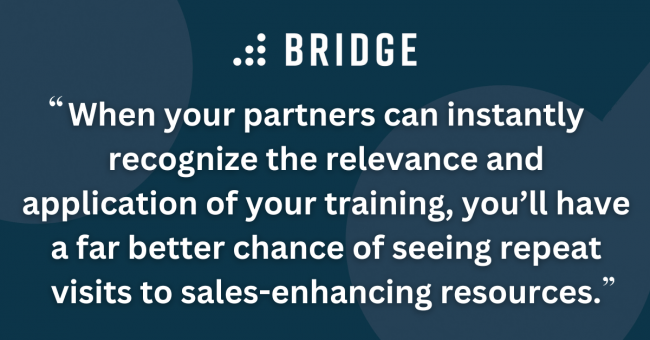
MORE FROM THE BLOG | ‘Bridge Journeys for Employee Development: How to Pave the Way for Success’
7) Deliver Relevant Content via Learner Segmentation
Learning pathways are a fantastic way to deliver well-paced content journeys—and they’re even more effective when the content they offer is relevant!
As such, you’ll want to look out for LMS features that allow you to group partners or customers based on their job role, location, or any other pertinent factors. This handy process will allow you to automatically enroll learners in the right courses before your automated learning journeys take the wheel.
Again, the key thing to remember is that your partners need that extra level of incentive in order to engage with your learning materials, and anything you can do to ensure that they’re willing to participate will pay dividends down the line. When your partners can instantly recognize the relevance and application of your training, you’ll have a better chance of seeing repeat visits to sales-enhancing resources.
8) Offer Personalization Options for Your Most Important Partners
Offering up content that’s relevant to your partners’ job roles is always going to be essential—but when it comes to your most important partner organizations, you might want to apply that principle of personalization to the entire learning experience. That’s where subaccounts come in.
Subaccounts are additional instances of your LMS nested under your main account. Giving your partners access to a subaccount allows them to operate within their own learning environment, allowing them to access any content you provide and add their own material into the mix.
With separate forms of authentication and custom branding options, subaccounts are a great way to demonstrate your commitment to partner training and help your biggest partners feel at home in your learning platform.
Craft Compelling Partner Training Programs With Bridge
Bridge’s award-winning LMS is bursting with the features you need to deliver training experiences that will keep your partners coming back. Create varied, time-released learning pathways with Bridge Journeys, assign those pathways to relevant people with smart groups, and take advantage of the suite of analytics, personalization, access, and incentivization capabilities Bridge has to offer.
